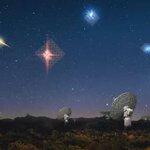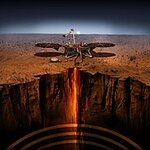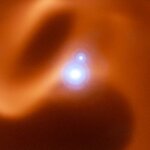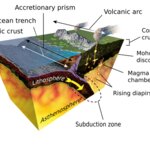Space

Short
summary - the risk from larger asteroids of 1 km upwards, large enough
to have some global effects is more or less retired as a result of
astronomical searches for the last few decades. There is still a risk
from smaller asteroids, but in most cases we’d be able to deflect them
if necessary, or evacuate the area. The chance of dying from an
asteroid is tiny, far less than the risk of dying of lighning.
20 - 40 METER ASTEROIDS ARE TINY - JUST
LARGE ENOUGH TO GET THROUGH THE EARTH’S ATMOSPHERE
An
asteroid 20 meters in diameter hits every 80 years or so. Since only 1%
of the Earth is…

A distant planet has an abundance of helium in its atmosphere so great that it has swollen to resemble an inflated balloon.
The helium of HAT-P-11b, 124 light years from Earth and in the Cygnus constellation, is blown away from the day side of the planet to its night side at over 10,000 km an hour. Because it is such a light gas, it escapes easily from the attraction of the planet and forms an extended cloud all around it.
And it's equivalent in size to Neptune. The helium is in an extended cloud that is escaping from the planet, just as a helium balloon might escape from a person's…

One of the most baffling puzzles of modern astrophysics is the nature of Fast Radio Bursts, which were discovered in 2007. These are seemingly rare, extremely bright flashes of light with radio wavelengths. They last only milliseconds; originate outside our galaxy, the Milky Way; come from regions with enormously strong magnetic fields; and pass through a significant amount of gas or dust before reaching Earth.
All of these facts may make it sound as though scientists know a lot about Fast Radio Bursts. In reality, we don’t. For instance, though we know they’re not from our galaxy, we don’t…

Coverage began at 2 p.m. Eastern (7 p.m. UTC). Landing started about 40 minutes later, the entire landing telemetry was streamed live through the briefcase sized Mars Cube One interplanetary "cube sats", and at around 3.01 p.m. EST they got first confirmation of the landing. First image from the surface arrived several minutes later, relayed through the cube sats, and the landing went without a hitch. See the timeline here NASA Landing on Mars milestones
Archived live broadcast of the landing
InSight lander artistic impression shows the mole deployed to right and the…

More Mars landing attempts have failed than on any other planet or moon due to one fundamental
physical property of Mars. That property is the atmosphere. This is the reality NASA will face Monday November
26th 2018 and every time they land on Mars. The Martian atmosphere
is just thick enough to burn up a space craft but too thin to slow it down for
a soft landing. For landing a space craft it is the opposite of a Goldilocks zone. Let us compare Mars to the planets and moons we have landed on
to see why that is the case.
Consider the Moon.
It has no atmosphere. Since it…

This is running as a scary story in the more sensationalist science outlets. Dark matter barely interacts with matter and if they are right we are right in the middle of it already. It can’t do any harm. It’s been doing this for all of human history and more.
It's not even like a wind. Not even like the pressure of light. It's like nothing at all.
Each second about a hundred billion neutrinos pass through every square centimeter of your body. You don't notice a thing. Nor do they notice you. They have to go through a light year of thickness of lead to stop half of them. And most dark matter…

Nothing to worry about for us. It's pointing in the wrong direction to ever harm us with the gamma ray burst jet. Their best fit model is that it is angled at 30 degrees to the line of sight.
It is too far away from us anyway at 8,000 light years. And there are no gamma ray burst candidates close enough to harm us. I go into that in detail in my article:
But this would be seriously bad news for any living beings that are on stars right close by within a few light years especially, along the line of the jet. Up to 50 light years away, it would cause significant effects on a planet like ours.…

This is a very bizarre click bait title from the NY Post that is scaring people. There is nothing here to worry anyone. It is not true at all,even the article itself says nothing about the planet exploding. Just some journalists inventive idea about a way to get people to click on the title?? Fake news. But the research is interesting, an interesting puzzle
Fake click bait title from the NY Post:
If Earth keeps sucking up its oceans, the planet might explode, study warns
Other articles are more accurate, here are a couple of the better ones, though they still give the mistaken impression…

Short summary: it's an entertaining but rather far fetched proposal in an arxiv preprint not published anywhere but mentioned in a Scientific American op ed. Implausible for many reasons including its spectrum which is not the shiny spectrum you'd expect from a solar sail but the red of tholins mixed with rock and metal as you'd expect from an asteroid / comet.
DETAILS
Oumuamua is the interstellar asteroid that passed Earth last year. Study of its orbit shows evidence of a small outwards push that gets less the further it is from the sun. You would expect that of an asteroid that is a kind of…

I am getting many people contacting me scared of this asteroid, which was proved to miss Earth back on 1st August 2002! Right now, it is coming from below Earth's orbit, but not directly towards us. We are circling the sun at the same time. It crosses Earth's orbit ahead of us. By the time we get to the place where our orbits cross, it is already high above our orbit and moving away. It will be closest on 13th January, but even then it is at a vast distance of 61 million kilometers away. We already knew this back on 29 July, 2002,
This is what the Carillo observatory, a private observatory in…